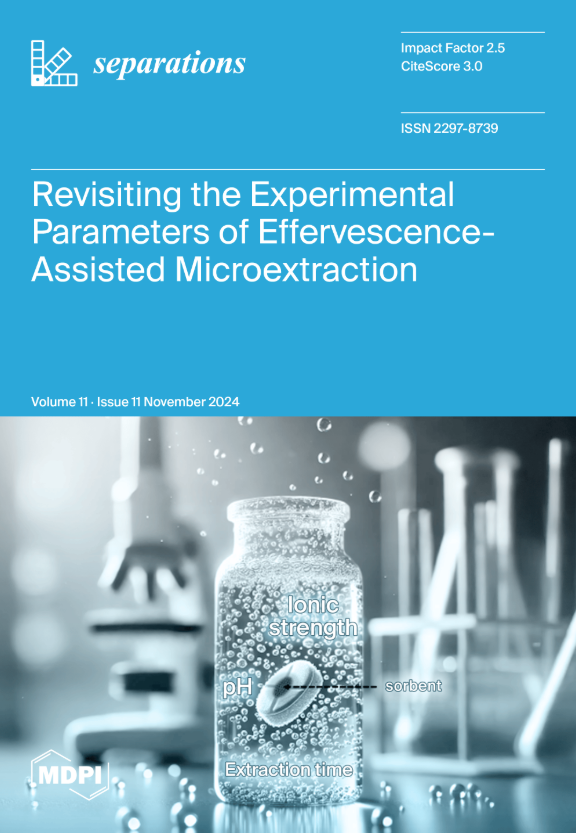A One-Step Sample Processing Method in Combination with HPLC-MS/MS for the Simultaneous Quantification of Atorvastatin, Ezetimibe and Three Metabolites including o-Hydroxyl Atorvastatin, p-Hydroxyl Atorvastatin, and Ezetimibe-Glucuronide in Human Plasma
IF 2.5
4区 工程技术
Q3 CHEMISTRY, ANALYTICAL
引用次数: 1
Abstract
A simple and sensitive liquid chromatography–tandem mass spectrometry (LC-MS/MS) method has been developed for the simultaneous determination of atorvastatin (ATOR), ezetimibe (EZM), and their three metabolites, including o-hydroxyl atorvastatin (o-OH ATOR), p-hydroxyl atorvastatin (p-OH ATOR), and ezetimibe–glucuronide (EZM-G) in human plasma using benzyl paraben (BP) as the internal standard (IS). The analytes and IS were ionized using ESI positive ion mode (ATOR, o-OH ATOR, and p-OH ATOR), ESI negative ion mode (EZM, EZM-G, and BP), and operated in multiple reaction monitoring (MRM) mode. They were then extracted via salting-out assisted liquid–liquid extraction with acetonitrile and analyzed via liquid chromatography on a reversed-phase chromatographic column (50 mm × 4.6 mm; 3.5 µm) using a mixture of acetonitrile and an acetic acid solution (0.5%) as the mobile phase, showing high extraction efficiency (>70%), and a minimized matrix effect. The method was satisfactorily validated, and it showed excellent linearity over wide concentration ranges of 0.06–15 ng/mL, 0.6–150 ng/mL, 0.4–100 ng/mL, 0.12–30 ng/mL, and 0.05–3 ng/mL for EZM, EZM-G, ATOR, o-OH ATOR, and p-OH ATOR, respectively.一种一步样品处理方法结合HPLC-MS/MS同时定量人血浆中阿托伐他汀、依替米和三种代谢产物,包括邻羟基阿托伐抑制素、对羟基阿托伐他汀和依替米葡糖苷酸
建立了以对羟基苯甲酸苄酯(BP)为内标(IS)同时测定人血浆中阿托伐他汀(ATOR)、依泽替米贝(EZM)及其3种代谢物o-羟基阿托伐他汀(o-OH ATOR)、对羟基阿托伐他汀(p-OH ATOR)和依泽替米贝-葡萄糖醛酸酯(EZM- g)含量的液相色谱-串联质谱(LC-MS/MS)方法。采用ESI正离子模式(ATOR、o-OH ATOR和p-OH ATOR)、ESI负离子模式(EZM、EZM- g和BP)对分析物和IS进行电离,并在多反应监测(MRM)模式下运行。用乙腈辅助液-液萃取法提取,反相色谱柱(50 mm × 4.6 mm;3.5µm),以乙腈和醋酸溶液(0.5%)的混合物为流动相,萃取效率高达70%,基质效应最小。该方法在0.06 ~ 15 ng/mL、0.6 ~ 150 ng/mL、0.4 ~ 100 ng/mL、0.12 ~ 30 ng/mL、0.05 ~ 3 ng/mL的浓度范围内具有良好的线性关系。
本文章由计算机程序翻译,如有差异,请以英文原文为准。
求助全文
约1分钟内获得全文
求助全文
来源期刊

Separations
Chemistry-Analytical Chemistry
CiteScore
3.00
自引率
15.40%
发文量
342
审稿时长
12 weeks
期刊介绍:
Separations (formerly Chromatography, ISSN 2227-9075, CODEN: CHROBV) provides an advanced forum for separation and purification science and technology in all areas of chemical, biological and physical science. It publishes reviews, regular research papers and communications. Our aim is to encourage scientists to publish their experimental and theoretical results in as much detail as possible. There is no restriction on the length of the papers. The full experimental details must be provided so that the results can be reproduced. There are, in addition, unique features of this journal:
Manuscripts regarding research proposals and research ideas will be particularly welcomed.
Electronic files and software regarding the full details of the calculation and experimental procedure, if unable to be published in a normal way, can be deposited as supplementary material.
Manuscripts concerning summaries and surveys on research cooperation and projects (that are funded by national governments) to give information for a broad field of users.
The scope of the journal includes but is not limited to:
Theory and methodology (theory of separation methods, sample preparation, instrumental and column developments, new separation methodologies, etc.)
Equipment and techniques, novel hyphenated analytical solutions (significantly extended by their combination with spectroscopic methods and in particular, mass spectrometry)
Novel analysis approaches and applications to solve analytical challenges which utilize chromatographic separations as a key step in the overall solution
Computational modelling of separations for the purpose of fundamental understanding and/or chromatographic optimization
 求助内容:
求助内容: 应助结果提醒方式:
应助结果提醒方式:


